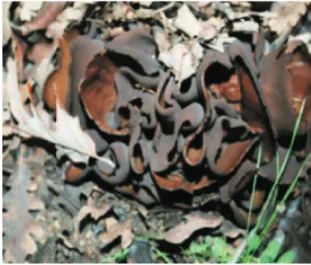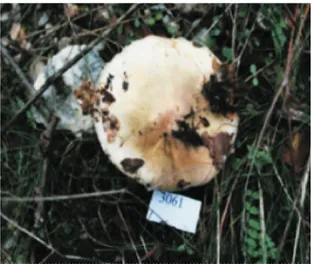Introduction
Many studies on macromycota have been done in Turkey. Clearly many mushrooms growing in different parts of Turkey have not yet been determined. About 400 articles published between 1852 and 2007 were examined. About 2400 macrofungal taxa have thus far been reported from Turkey (Sesli & Denchev, 2005; Solak et al., 2007).
Buldan is a district in the province of Denizli and is located in a region with a Mediterranean climate. Therefore, typical Mediterranean plants including Pinus brutia Ten., Quercus ilex L., and Q. cocifera L. are widespread in the region. Because of the suitable climate and the type of common vegetation, the region has a rich macromycota.
Materials and Methods
The specimens were collected during field trips in the area in 2006. The morphological and ecological characteristics of the macrofungi were recorded and
photographed in their natural habitats. The specimens were brought to the laboratory. After their spore prints were taken, dried specimens were numbered and placed in sealed bags. In addition, they were placed in a deep freeze for 1 week to protect against internal and external parasite attacks.
The specimens were identified with the help of some reference books (Marchand, 1971-1986; Phillips, 1981; Moser, 1983; Breitenbach & Kränzlin, 1984-2000; Watling & Gregory, 1987). All specimens have been deposited at the fungarium of Mu¤la University.
Results
List of Taxa ASCOMYCETES Pyronemataceae
1.Otidea bufonia (Pers.) Boud.
Fruiting body 1-6 cm diameter, cup-shaped and usually slit, and somewhat inrolled, becoming irregularly Turk J Bot
32 (2008) 171-173 © TÜB‹TAK
171
Three New Macrofungi Records from Turkey
Hakan ALLI1,*, Aziz TÜRKO⁄LU2, Mustafa IfiILO⁄LU1
1Mu¤la University, Faculty of Science and Arts, Department of Biology, Mu¤la - TURKEY 2Nevflehir University, Faculty of Science and Arts, Department of Biology, Nevflehir - TURKEY
Received: 02.05.2007 Accepted: 14.01.2008
Abstract: This study is based on macrofungal specimens collected from Buldan district (Denizli) in 2006. As a result of field and laboratory studies, 3 new records of macrofungi species were determined for Turkey. These are Otidea bufonia (Pers.) Boud., Hebeloma cavipes Huijsman, and Russula nauseosa (Pers.) Fr.
Key Words: Macrofungi, new records, taxonomy, Turkey
Türkiye’ den Üç Yeni Makrofungus Kay›tlar›
Özet: Bu çal›flma Buldan (Denizli) yöresinden 2006 y›l›nda toplanan makrofunguslar üzerinde yap›lm›flt›r. Arazi ve laboratuvar çal›flmalar› sonucu tan›mlanan türlerden 3 tanesi Türkiye için yeni kay›tt›r. Bunlar; Otidea bufonia (Pers.) Boud., Hebeloma cavipes Huijsman ve Russula nauseosa (Pers.) Fr.’ d›r.
Anahtar Sözcükler: Makrofunguslar, yeni kay›tlar, taksonomi, Türkiye
Research Note
wavy (Figure 1a), inner surface dark, outer surface slightly paler. Flesh thin, brown. Sometimes solitary, but principally growing in groups and crowded together. Asci 150-180 × 9-11 µ, not bluing with iodine. Spores elliptic-fusiform (Figure 1b), 13-15 × 6.5-7 µ, hyaline, containing oil drops.
Denizli, Buldan, Çatak, at the bottom of valley on Süleymanlı road, on mossy ground, 19.11.2006, Türko¤lu 3307.
BASIDIOMYCETES Bolbitiaceae
2.Hebeloma cavipes Huijsman
Cap 3-5 cm diameter, obtusely conical to hemispherical at first, later convex to plane with a flat
umbo and slightly indented in the centre (Figure 2a), whitish to cream-coloured at first, yellow-ochre toward the centre, later surface smooth, silky, margin even and incurved for a long time. Flesh white to beige coloured, thin, odour slightly raphanoid. Lamellae cream-coloured at first, later grey to pink-brown, ascending and broadly attached, edges white-floccose. Stipe 4-6 × 0.5-0.7 cm, cylindrical, flexuous, sometimes twisted, solid at first, hollow later, flexible, surface white-pruinose when young, later pruinose at the apex. Spores amygdaliform (Figure 2b), 10-12 × 6-7.5 µ, slightly verrucose, light yellow. Spore print olive-brown.
Denizli, Buldan-Sarıgöl road, Kelledere district, in pine forest, under Cistus laurifolius, 4.11.2006, Türko¤lu 3067, 3088.
172
Three New Macrofungi Records from Turkey
10µ
10µ Figure 2. Hebeloma cavipes; a) basidiocarps b) basidiospores.
Figure 1. Otidea bufonia; a) ascocarps b) ascospores.
@ı
.
Russulaceae
3. Russula nauseosa (Pers.) Fr.
Cap 2-5 cm diameter, hemispherical at first, later plane, undulating (Figure 3a), surface dull when dry, shiny when moist, pale wine-red to a delicate pink, margin obtuse and striate. Flesh white, odourless, taste mild. Lamellae cream-coloured at first, later light ochre to yolk-yellow. Stipe 2-6 × 0.5-1.2 cm, cylindrical, solid initially, later hollow, surface slightly longitudinally venose, white at first, later grey. Spores subglobose to elliptical (Figure 3b), 7-9.5 × 6-7.5 µ. Spore print cream. Denizli, Buldan, Süleymanlı plateau, in pine forest, 4.11.2006, Türko¤lu 3061; Buldan, Çatak, in graveyard 4.11.2006, Türko¤lu 3076.
Discussion
Although according to the recent literature (Solak et al., 2007) the number of Turkish macrofungi is about 2400, new records have been observed from time to time. In this study, 3 new records of macrofungi are reported from Buldan district (Denizli). Otidea bufonia is very similar to pezizas; however, it differs in its spores being elliptic-fusiform and containing 2 oil drops. Hebeloma cavipes is recognised easily by its radish smell and rough spores at the generic level, and characteristics of Hebeloma cavipes are the bottle-shaped cheilocystidia at the specific level. Russula nauseosa grows under pine and is known by its mild taste and wine or pink colour.
H. ALLI, A. TÜRKO⁄LU, M. IfiILO⁄LU
173 10µ
Figure 3. Russula nauseosa a) basidiocarps b) basidiospores.
References
Breitenbach J & Kränzlin F (1984-2000). Fungi of Switzerland. (Volume 1-5), Luzerne: Verlag Mykologia.
Brensinsky A & Besl HA (1990). Colour Atlas of Poisonous Fungi, London: Wolfe Publishing.
Marchand A (1971-1986). Champignons du nord et du midi, 1-9, Perpignan: Société Mycologique des Pyrénées Méditerranéennes. Moser M (1983). Keys to Agarics and Boleti, Stuttgart: Gustav Fischer
Verlag.
Phillips R (1981). Mushrooms and Other Fungi of Great Britain and Europe, London: Pan Books Ltd.
Sesli E & Denchev CM (2005). Checklist of the Myxomycetes and Macromycetes in Turkey. Mycologia Balcanica 2: 119-16. Solak M H, Iflılo¤lu M, Kalmıfl E & Allı H (2007). Macrofungi of Turkey
Checklist, ‹zmir: Üniversiteliler ofset.
Watling R & Gregory NM (1987). British Fungus Flora 5: Strophariaceae & Coprinaceae: Royal Botanic Garden, Edinburgh.

